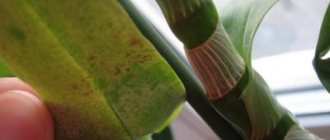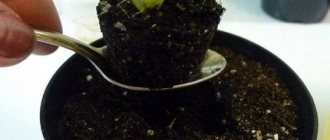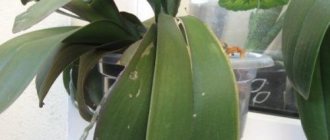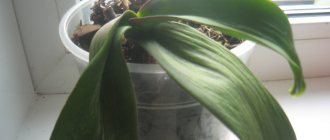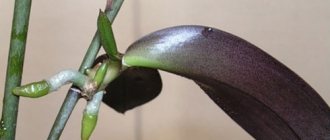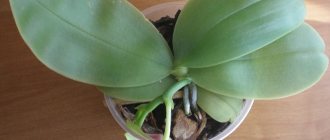What is it and what does it look like?
Sometimes, looking at a plant, you will notice that 1-2 lower leaves have turned yellow and are drying out, while the rest still remain richly green and healthy. Why does this happen and what needs to be done to restore the plant to a healthy appearance? In this case, do not panic: a natural process occurs, as a result of which the lower leaves turn yellow and fall off. The orchid sheds its old foliage in this way.
If the leaves of an orchid first lightened, became limp, and then yellow spots began to form on them, or if the leaves began to turn yellow at the base or on one side, and then the stem began to turn black or acquire a yellow or brown color, this is a sign that there were the rules for caring for the plant have been violated or the plant has become ill.
Photo of the affected flower
Here you can see what an orchid with yellowed leaves looks like:
Why do the lower leaves of an orchid turn yellow?
Also check out these articles
- Why tomatoes grow poorly and what to do
- What to feed lambs
- How to plant watermelons with seeds
- Shrub Barberry Thunberg
Aging is one of the most common reasons why orchid leaves turn yellow. This fact is rarely considered by novice gardeners; they immediately begin to suspect disease, improper care, or unsuitable conditions for growth. And yet, although the orchid is a persistent crop, it can also age. Over time, the leaves turn yellow and fall off so that new, young ones can grow. This is a completely natural process that cannot be prevented or stopped.
Yellowed orchid leaves
Interesting!
Seasonal yellowing and complete loss of foliage can be observed exclusively in the Dendrobium orchid.
It is very easy to determine that the leaves are just getting old - the lower leaves will turn yellow, not the upper ones - only the lower tier! The process lasts a long time, for 2-3 months. So if the lower leaves have turned yellow, but all the rest have a natural color, then the reason is precisely aging. This process is characteristic primarily of the Paphiopedilum and Phalaenopsis species.
What are the reasons?
The main reason for the appearance of yellowness on orchid leaves is a violation of the rules of plant care. The most common causes of yellowing leaves include:
- Bad light. This plant needs bright lighting, but the light should be diffused. If the orchid's leaves begin to turn yellow on only one side or yellow spots appear on the leaves, this means that the plant has received sunburn. If all the leaves turn yellow and become limp, this means that the plant, on the contrary, does not have enough light.
- Incorrect watering. This beautiful flower loves regular watering. But sometimes, if this condition is met, you may notice that the foliage begins to turn a little yellow. This means that the plant has been flooded. This happens when the pot for the plant is too small, and the excess moisture simply does not have time to escape. Also, the cause of yellowing of the leaves may be a violation of the level of air humidity in winter.
- Bacterial or fungal infection. If a flower is affected by this disease, yellowness is visible not only on all leaves, but also on the stem. Another sign of this disease is the high rate of spread of yellowness. In such a situation, it is almost impossible to save the plant.
- Violation of transplant rules. If the flower is not replanted in time, the overgrown measles system no longer fits in the pot and becomes deformed, and yellow spots appear on the leaves.
- Potassium deficiency. This leads to the fact that a biochemical process begins to occur in the plant, including the redistribution of potassium from old tissues to new ones, as a result of which mature leaves turn yellow and die.
- Lack of iron in the soil substrate. This can be caused either by an initially incorrectly selected soil mixture when planting the plant, or by watering with low-quality tap water.
- Lack of nitrogen in the substrate. In this case, the leaves turn yellow but do not fall off.
- Chemical burn. This happens when the soil is fertilized excessively, when a concentrate that is too saturated is used when watering.
- Unscrupulous seller. As you know, the larger the specimen, the more expensive its price. Therefore, many sellers use various stimulants to accelerate plant growth. Therefore, situations sometimes arise when, 1-2 years after purchase, the leaves turn yellow at the base, stop growing and fall off. This is a sign that the seller has gone too far with stimulants.
Why is this happening?
There are different reasons why leaves turn yellow:
- naturally;
- due to a burn;
- due to lack of light;
- excess or lack of nutrition;
- due to a virus;
- due to bacteria;
- due to fungus;
- due to lack of moisture.
- Natural aging. Old phalaenopsis are vulnerable, and they begin to turn yellow first.
- Burn is damage to leaves caused by sunlight. At this point, pale brown spots are observed on the plant.
Causes of burns:- Direct sunlight hitting the wet surface of the leaf.
Sudden temperature fluctuations.
- Concentration from the glass when the light is turned on.
- Lack of light. It makes the leaves look withered, drooping and lose their natural color.
- Excess or lack of nutrition. Due to lack of nutrition, the upper leaves of the orchid turn yellow. How to understand what plants lack?
- Magnesium - a white border appears around the veins along the contour.
- Nitrogen - the tips and veins turn yellow.
- Calcium - the leaves become deformed and take on an irregular shape.
- Zinc - leaves seem to burn out and become discolored.
- Gland - leaves turn yellow and decrease in size.
- Potassium - the edges and tips turn yellow, but the veins do not change color.
- Viruses. There are 2 types of viral plant diseases: jaundice and mosaic.
Signs of jaundice:- dwarfism;
yellowing;
- excessive branching;
- twisting
Reference. Most often, burns occur at high temperatures and low humidity.
Mosaic features:
- Mottling.
- Mosaic.
- Spotting.
Multiple infections are possible when several different viruses are present in the plant. This is more difficult to treat. Also, in the presence of viruses, symptoms may be absent, and the plant may die from the inside.
When should you worry?
As noted above, orchid leaves may turn yellow at the base or completely and fall off due to natural reasons.
Attention! If, in addition to yellowness, other symptoms indicating a disease appear, this should cause concern to the grower.
Such symptoms indicating that the plant is sick or the conditions of its maintenance have been violated include:
- The appearance of signs of rot on roots, leaves and stems.
- Weeping spots on leaves and stems.
- Drying.
- Withered leaves.
- The lower tier of leaves or one side of the plant has completely turned yellow.
- The appearance of brown spots on leaves and stems.
Structural features of the Phalaenopsis orchid
Household orchids are epiphytes - plants with an open root system covered with velamen. Through the porous layer, orchids absorb moisture from the environment and soil; in nature they grow on trees or rocky gorges.
Modern, “domesticated” species can be divided into groups according to the complexity of care:
- For beginner flower growers. These are the most adapted plants: Dendrobium, Phalaenopsis, Epidendrum.
- For advanced gardeners. These are: Brassia, Coelogina, Dendrobium.
- For professional orchid breeders: Cattleya, Miltonia, etc.
According to the type of growth, orchids are sympodial and monopodial. Sympodial plants have horizontally growing shoots united in a rhizome. Peduncles emerge from the shoots, usually one or two (depending on the species of the orchid).
In some sympodial plants, shoots appear with leaves from which flower stalks emerge.
At the base of the shoots there are thickenings - bulbs, which serve to accumulate water and useful substances for future shoots. But the structure of the bulbs differs from classic flower bulbs, so it would be more correct to call them “pseudobulbs.”
The monopodial type includes Ascocenda, Vanda and Phalnopsis orchids. The plant develops from one main shoot, with alternate growth of leaves. Phalaenopsis have thick shoots similar to bamboo, and they also serve for reserve accumulation of moisture and nutrients.
Long-term consequences
If measures are not taken in time, the beautiful orchid may stop blooming, dry out, or the process of rotting may begin, which will ultimately lead to the death of the entire plant.
If the cause of yellowing leaves is an infection, then unless appropriate measures are taken, there is a risk of the disease spreading to other plants.
Methods of treating an exotic beauty
Drying leaf blades
The leaves of the orchid have turned yellow, what should I do? Experienced flower growers answer this question that again it all depends on the reason. So, if a leaf dries out and turns yellow according to the natural cycle, then the leaf plate cannot be touched. Despite her condition, she continues to nourish the plant. You just have to wait, the leaf should dry and fall off on its own.
It’s another matter if drying leaves indicate more serious problems, such as infections.
In this case, a broad-spectrum antibiotic should be used. A fungicide would be suitable, for example:
- Alirin;
- Mikosan;
- Copper sulfate;
- Bordeaux mixture;
- Quadris, etc.
It is necessary to treat the plant following the instructions in the instructions. The previously dried leaf is removed.
Signs of infection
Restoration of yellow leaves
If the leaves have not dried out at all, and the reasons are not infections, but improper maintenance, then restoring the plant in this case is not difficult.
Lighting
Among the main reasons for yellowing leaves is lack of lighting. In this case, the plant is placed in a bright area, preferably on the east or south side of the apartment. A little shading is required. In autumn and winter, additional lighting is needed in the form of fluorescent lamps.
Elimination of solar activity
If chlorophyll is no longer produced due to sunburn, the plant is moved to another location. If the sheet is severely damaged, it is removed.
Note! Artificial lighting also needs to be installed correctly. Lamps should not be placed at a distance closer than 15-25 cm relative to the plant.
Organizing proper watering
If the plant does not receive enough water, its roots begin to dry out, measures should be taken. It is best to remove the flower from the container with the substrate and immerse it in a container of warm water. Immersion occurs only in the root system. The green mass should not be wetted.
It is also possible to save a plant that, on the contrary, has been flooded. To do this, the rhizome is removed from the pot and inspected for putrefactive damage. If they are not there, then the roots are slightly dried and transplanted into a pot with new soil.
Working with fertilizers
If the plant is overfed, it is removed from the pot, the roots are washed in warm water and replanted in new soil. After 14 days, it is allowed to apply a low-concentration combination preparation for orchids. If the leaves turn yellow due to a lack of elements, then fertilizing should be organized.
Transfer
An important condition for the health of an exotic beauty is that the pot has the optimal volume. Yellow leaves may indicate the need for replanting
In this case, the plant is transferred to a larger container.
To give a flower health, it must be replanted on time.
Treatment of rhizomes
The flower will disappear if the rotten roots are not treated. First, the roots are inspected. Brown color and fragility indicate approaching death. The plant must be treated promptly:
- The roots are carefully cleaned from the substrate by hand.
- Take a sharp knife. It is disinfected with an alcohol solution.
- The fibrous, rotten, dead areas of the rhizome are cut off with a knife.
- All places touched by the knife are treated with brilliant green. You can use ash instead.
- Next, the plant is transplanted into new soil.
- Watering in the first 3-5 days is prohibited. It is best to place a basin of water nearby. Water will humidify the air around the exotic.
Treatment for yellowing
If it has been noticed that the leaves of an orchid are not turning yellow due to a natural process, in order to save the plant, you need to do the following:
- Analyze the conditions of detention. It is necessary to check whether the flower is exposed to direct sunlight, check the soil for excess or lack of moisture, check whether the root system has grown and whether the pot has become too small for it.
- If it is discovered that the flower is suffering from sunburn, it must be rearranged.
- If the cause is insufficient watering, then you must:
- Check the soil in the pot. It should be moist.
- If the soil is dry, then it is necessary to moisten it with filtered water.
- We decide to observe watering and monitor the condition of the flower.
- If the cause is excessive watering, then you must:
- Remove the plant from the pot and clean it of the substrate.
- Check the root system for rot.
- If rotten areas are found on the roots, they must be cut off with a sharp blade disinfected in a solution of potassium permanganate. Sprinkle the cut areas with charcoal.
- Replant the orchid in a new pot.
- If the cause is a lack of potassium, nitrogen and iron, then it is necessary to apply fertilizer containing the necessary substances. Introduce fertilizers gradually, monitor changes in the condition of the flower (there are improvements or nothing changes).
Next, we will tell you what to do if the leaves of the plant turn yellow and fall off.
What to do if the leaf blades are affected?
- If it turns yellow from a burn, you need to:
- Move it to the shade.
- If the damage is minor, it is better to leave the leaves, as they feed the entire plant.
- Spray with epin (an artificial biostimulant that helps with temperature changes, hypothermia, burns, etc.)
- Wait for the burnt leaves to dry. If this is difficult, you need to help them by powdering them with activated carbon.
- Carefully remove dried leaves.
- Aging process. If your orchid is more than 5 years old, then it has begun to turn yellow for natural reasons.
Watch:- The rate of yellowing of the leaves is slow - several months.
They turn yellow gradually from the lowest leaves.
- Despite the yellowing, the flower grows and blooms.
- If the orchid has turned yellow from lack of light:
- Get her out of the shadows.
- Water the flower with a solution of B vitamins.
- Place the plant under a phytolamp.
- If the orchid has yellow leaves due to excess or lack of nutrition.
Deficiency in orchids is extremely rare. Their diet is designed in such a way that they do not need additional nutrients. But if this does happen, then watch the leaves.Important. It is difficult for non-professionals to understand what exactly a flower lacks, so it is better to take a complex fertilizer for orchids.
- Leaf problems due to viruses and fungi:
- Get rid of bad roots.
- Use specialized sprayers against viruses and fungi.
- Replant into new soil and pot.
- What to do if the orchid does not have enough moisture? Create a new watering schedule and monitor the leaves and root system.
If the roots are dried out, they take all the moisture from the leaves.
During this period nothing is required from you. Do not interfere with this process and do not cut off the yellow leaves, as they still contain a large supply of nutrients.
How to save if they lose turgor, turn yellow and fall off?
If the orchid leaves not only begin to turn yellow, but also fall off, then the plant must be urgently revived:
Analyze the conditions of the flower and identify possible causes of the problem.- Change the mode and methods of watering.
- Move the flower pot to another place.
- If the orchid is located next to yucca, peperomia, cordilina or ararkaria, then it is necessary to move them away.
- Replace soil and pot. A new pot must be disinfected with a solution of potassium permanganate before planting.
- Do not use fertilizers or growth stimulants for at least 14 days.
- If fungal or bacterial diseases are detected on the orchid, it must be treated with fungicides.
Important! Only soft water should be used for irrigation.
How to get rid of it?
How to deal with these pests in order to get rid of them? At the first signs of thrips, you should isolate the affected plants from the rest of the collection so as not to spread the pest. On orchids, thrips most often settle on flowers, so peduncles with already opened flowers are cut off. The buds are also removed - thrips lay eggs in them. If traces of insects, their eggs or larvae are noticeable on the growths and leaves, remove them with a damp cotton pad. Treat sick orchids with anti-thrips medications, strictly following the instructions on the package. Preference is given to systemic drugs
Repeat treatment if necessary. For several days in a row, you need to thoroughly rinse the soil and the orchid itself under warm running water. This procedure will reduce the number of pests. Important! After water procedures, it is necessary to remove moisture from the axils of the leaves with a cotton pad or place the plant in a room with good ventilation. Stagnant water is detrimental to many types of orchids.
You can learn more about what thrips are and how to deal with them on indoor plants here.
Chemicals
To destroy the pest, a variety of liquids and sprays are used, some of them have an oily base. Often these are contact drugs. They act in direct contact with insects and their eggs. When working with such products, follow the dosage, because... these substances can damage orchid leaves.
Systemic drugs take the form:
- granules;
- powders;
- water-soluble emulsions;
- sticks.
Such substances penetrate inside the plant itself and make it poisonous to the pest.
The most popular preparations in indoor floriculture are:
- Aktara;
- fitoverm.
They are systemic fungicides and are relatively easy to use.
When working with fungicides, take precautions as... many drugs are poisonous
After handling, be sure to wash your hands.
Biological agents
Sometimes biological plant protection products are available on sale. These can be jars, bags and labels, which contain predatory species of bedbugs or mites that prey on other insects. These containers are placed next to the plants and opened to allow beneficial insects to settle on the orchids.
Traditional methods of pest control
The most popular and easiest to use is soap solution. A small piece of soap is dissolved in 250 ml of warm water and the resulting solution is sprayed on the plant.
After 15-20 minutes, the solution is washed off, and the orchid is washed well with clean water. Attention! The soap solution clogs the stomata of orchids, which can affect the appearance of the plant. If the condition of the plant worsens after treatment, it is better to change the method of control.
Popular articles Brick-red honey fungus: appearance, where it grows, fruiting time
Tobacco infusion is also used to combat thrips
To do this, 80-100 grams of tobacco dust are soaked in 1 liter of water, then the mixture is filtered. The resulting liquid is sprayed on the orchid.
In the summer, a decoction of marigolds is used against thrips. Several inflorescences (60 g) are crushed, pour in 1 liter of water and bring to a boil, then cook over low heat for one and a half minutes. The liquid is cooled and allowed to brew for 3 days, filtered and the decoction is sprayed on the affected orchid. Water-oil emulsion is also widely used to control thrips. Add 2-3 tablespoons of sunflower or olive oil to 1 liter of water, shake and quickly apply to the orchid by spraying.
Subsequent care of the plant at home
After the orchid has recovered and its leaves have turned green again, you must begin to follow the rules of care:
- Provide the flower with enough light. The orchid requires a lot of diffused light. Daylight hours should last 10-12 hours.
- Compliance with the temperature regime: during the day it should not be 18-27 degrees above zero, at night – 13-24 degrees.
- Providing a difference in air temperature between day and night is a necessary condition for good orchid flowering.
- Follow the watering schedule. The soil should be moist, but not wet, and even more so, the water should not stagnate in the pot. Water for watering the orchid must be used soft, and its temperature should be 2-3 degrees warmer than the surrounding air.
- Fertilizers must be applied no more than once every 2-3 weeks; be sure to follow the proportions indicated on the package. After transplanting the plant, it is not recommended to apply fertilizers, since the substrate already contains all the necessary substances.
- Monitor the quality of the substrate and the degree of growth of the root system. Replant the plant in time.
Thus, there are a large number of reasons for the appearance of yellowness on leaves, and they are associated both with natural processes and with violation of the rules of care. If the yellowing of the leaves is not caused by natural causes, then the lack of timely surgical intervention can lead to the death of the plant.
We bring to your attention other articles about the yellowing of the orchid, including the stem and peduncle of the plant, as well as about the drying of the roots and yellowing of the leaves.
Insufficient watering as one of the main mistakes in care
A very common reason for orchid leaves changing color from green to yellow is insufficient watering. Why do orchid leaves turn yellow due to the substrate drying out? Moisture deficiency disrupts metabolism, slowing down the flow of nutrition to the stems and leaves. The reaction of the flower in this case will be the appearance of unhealthy coloring of the leaves. This happens only in the most advanced cases.
For example, phalaenopsis. An unpretentious, common orchid. In an externally healthy plant with normal roots, the leaves acquire a yellowish tint. This situation is possible even with timely watering. The reason for the lack of moisture in orchids lies in the structure of the planting soil. The orchid planting mixture most often consists of pieces of coniferous tree bark.
Irrigation water, flowing through the substrate, flows into the pan, preventing the roots from being saturated with moisture. Young leaves do not have enough nutrients and phalaenopsis has to redistribute nutrients from older leaves to young ones. Old orchid leaves turn yellow. In this case, eliminating such yellowing is very simple.
It is enough to water the orchid using the immersion method. A pot of phalaenopsis is immersed in a container of water. Dive time is individual. Through the transparent walls of the pot you can see when the orchid's roots turn from gray to greenish. This will be a signal that the roots have received enough moisture. If you switch to such an irrigation system, in one to two weeks the water balance of the flower is restored, and the yellowing of the leaves stops.
When can a plant no longer be saved?
In especially advanced cases, when the problem was not detected and solved in a timely manner, it may no longer be possible to bring the flower back to life.
If serious damage to the root system has occurred, as a result of which most of the roots have died, or when rot and mold have already spread to the above-ground part of the plant and led to large-scale damage, there is practically no chance to save the orchid (read about how to save phalinopsis and grow new roots here).
Choosing the right orchid
This is a very exotic flower for our area. The most famous domestic species are Cattleya, Phalaenopsis, Dendrobium, Vanda, Rhynhostilis, Epidendrum, Paphiopedilum. Each of them requires special care, which novice amateur gardeners rarely know about.
Despite the fact that the overwhelming majority of people properly care for the crop, its leaves still turn black and yellow. When purchasing, it is important to choose the healthiest specimen so that the orchid does not shed its green crown - this way the likelihood that it will have problems in the future is significantly reduced.
There should be no unusual spots, growths, or physical damage on the foliage, bulbs (organs designed to accumulate reserves of useful substances in certain species), and the stem. If the magnification point is injured or completely missing, such a copy is not worth buying - it will no longer become full-fledged. When several leaves are cut, the plant may be breaking and the seller has removed areas where this is noticeable.
It is advisable to visually assess the condition of the roots - ideally they are dense, greenish-gray. Rotten areas and dark brown roots are not allowed. The orchid should sit densely in the flowerpot - if it “dangles”, it means the transplant took place quite recently, the culture has not yet become stronger. The store should clarify what conditions are required for a particular variety - some suppliers provide each with a small brochure with a brief description and care instructions.
What to pay attention to:
- When purchasing in the cold season, the transportation period should be short; the valuable crop should be carefully insulated. To do this, it is tightly wrapped in several layers of paper and newspapers, always closing it on top. Prolonged exposure to sub-zero temperatures can destroy the flower.
- For most orchids, the optimal temperature is between +20-28 degrees, humidity - 75-80%.
- It is preferable to buy flowers in special nurseries and greenhouses - they are taken care of a little better there than in the nearest supermarket, and transported more carefully, which eliminates injury.
- Purchasing a blooming specimen is not always good - almost all the orchid’s energy is spent during this period, and it may simply not take root in a new place. Choose a plant with buds, but still closed.
- Pseudobulbs of Dendrobium, Cattalea, Cymbidium, Oncidium, and other species should be dense, not withered, not wrinkled. If the leaves are too shiny, large, glossy, this is a sign that the flower is overfed with fertilizers and is unlikely to bloom in the near future.
Diseases and pests
Pests can be brought into a flower from a store or from the street. Main types of insects:
- Aphid. Collected on the back side of the sheet. Sucks out nutrients. It looks like a cluster of black or green dots.
- Shield. Dark growths on the back of the plates, larger than aphids.
- Spider mite. Small red insect. Leaves a small cobweb on the plant.
The orchid is also affected by infectious diseases. The most common problem is black rot. It occurs when a flower overflows. Signs: black spots on roots, stems, foliage, unpleasant odor, falling leaves. Another infection, but of fungal origin, is powdery mildew. Penetrating through the spores, it begins to feed on the orchid leaves, gradually destroying them. Signs: plaque, sour smell, lumpy leaf blades.
How to recognize why a plant disappears?
The main signs of violations in care and diseases are indicated above, but sometimes they are not enough to determine the cause of wilting. Let's take a closer look at the symptoms and related problems.
Why does it turn white and wither?
Leaf blades turn white mainly due to powdery mildew. This fungus sucks nutrients from the plantings and dries out the leaves. Powdery mildew can be identified by a white coating, which is difficult to separate from the flower, and by an unpleasant sour smell.
Important! A light coating also appears when thrips attack. You can detect them by points using a magnifying glass
Transparent insects are invisible to the naked eye.
Why do yellowed leaves fall off?
There are many reasons for leaf fall:
- lack of potassium;
- natural renewal of the plant;
- fungus or bacterial infection;
- stress after a sudden change of environment.
Note! Since the falling of leaf blades is too common, a general symptom, the grower can only look for other symptoms in order to diagnose the plant.
If all the leaves have fallen
Some plants, in particular sympodials, completely change foliage after flowering. When purchasing, you need to check with the seller whether the selected variety is prone to this. But this rarely happens; much more often, the reason for all the leaves falling off is improper care.
Due to parasites, complete shedding of foliage rarely occurs. The following can affect an orchid:
- root rotting;
- lack of moisture;
- critical burn;
- lack of fertilizers;
- bacterial infection.
